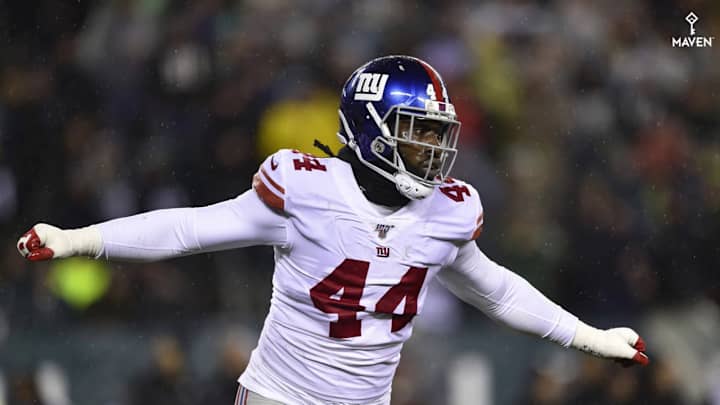How to Fix the Giants Pass Rush

You don't have to be the second coming of Madame Cleo to accurately predict that the league's top pass rushers are bound to receive the franchise tag to discourage would-be suitors from other teams from throwing money at them.
Unfortunately, in having done so, that likely means that pass rushers who might otherwise be viewed as a No. 2 guy (translation: someone an opposing offense might not necessarily game plan for or consistently devote additional resources to stop), will be the lucky ones who get to cash in on deals that will likely exceed their actual value.
So what's a team like the Giants, who haven't finished a season ranked in the top-10 league-wide in sacks since 2014 when their 47 sacks put them in fourth place, to do?
Read on, and I'll tell you.
Why it's a need
When it comes to quarterback sacks, the Giants have finished in the bottom third of the NFL in four out of the last five seasons, the lone exception being in 2016 (also their lone playoff season in that stretch) when they finished 14th with 35 sacks.
If we're being fair and looking at the entire picture, part of the problem has been the scheme and how players have been used. In our film study on Lorenzo Carter's use in James Bettcher's defense, we outlined why we believe Carter didn't take the big jump forward as a pass rusher that many people were anticipating.
The other part has to do with the back end of the defense, where if the cornerbacks aren't holding their coverage, that can affect a pass rush.
Still, if you go back and look at the Giants' playoff teams of 2007, 2011 and even 2016, the one thing those three teams had in common was at least two pass rushers that forced opponents to "pick their poison" regarding on whom extra resources needed to be devoted.
The Giants have tried to do that the last couple of years, adding Carter in 2018 and then Oshane Ximines last year. They also took a flier on Markus Golden, who was two years removed from a devastating knee injury.
He rewarded their faith in him by delivering the team's first double-digit sack performance since defensive end Jason Pierre-Paul recorded 12.5 sacks in 2014, the year the Giants finished fourth league-wide in sacks with 47.
But in breaking down Golden's sacks, a good number came on inside twists rather than off the edge.
While a sack on a twist is as good as any, the Giants have struggled to find a legitimate pass rusher who can bend the edge from that 5-tech or 9-wide spot (Carter being the closest they have, though again, Carter was mostly used to attack inside gaps, which were not a strength).
How to address it
Ask any general manager if they'd love to have a guy capable of generating double-digit sacks on an annual basis and if you found one who said no, then his team should fire the man on the spot.
But unfortunately, there aren't enough of those guys to go around, and this draft class, while having some good players in it, pretty much has Chase Young as its premier pass-rushing candidate before there's a noticeable dropoff in terms of potential production.
And if we're talking draft, there's Ohio State edge rusher Chase Young, a premier talent who probably will be gone by the time the Giants are on the clock. Then there are Day 2 and Day 3 pass rushers such as Iowa's A.J. Espenesa and Boise State's Curtis Weaver, who may or may not make an immediate impact but who could potentially grow into a role.
So teams like the Giants, who need to bolster their pass rush, might have to rely on the creativity of defensive coordinator Patrick Graham to develop a plan that incorporates how the personnel is used to manufacture a pass rush.
But first, let's look at the players and what the Giants need. I'd start with re-signing Markus Golden, who last year over delivered on a one-year, $3.75 million "prove it" contract.
Not only did Golden deliver the goods to the pass rush by taking advantage of the schemes in which he was placed, but he was also solid against the run, which is an often-overlooked factor by people who go searching for the "perfect" pass rusher.
As previously noted, Golden is not a No. 1 pass rusher who can bend the edge, and his game is more about speed, which he showed he still has even after the knee injury.
In bringing Golden back, the Giants are not only getting a guy who was good for their locker room, but who is also one with whom the front office is familiar to where bestowing a contract averaging $13.5 million per year (Spotrac's estimated market value) makes more sense.
Bringing back Golden, though, is one step. It's up to defensive coordinator Patrick Graham to better utilize Carter and Ximines to where potentially the Giants can develop that three-headed pass-rushing monster that will force opposing offenses to "pick their poison."
As noted in our film study, allowing Carter to play that 'hunter" role on defense might be the key that unlocks the pass-rushing potential the front office brass believes the third-year defender is capable of producing.
What about Jadeveon Clowney and Yannick Ngakoue?
Jadeveon Clowney was traded last year from the Texans to the Seahawks and managed just 3.0 sacks in a what-have-you-done-for-me-lately league. Before that, as part of a defense with J.J. Watt, Clowney recorded 67 quarterback hits with 29 sacks--not horrible numbers but numbers that probably should have been a little better.
Is that enough production to justify a projected market value of $20 million per year based on a six-year, $120.3 million contract?
Probably not.
As for Yannick Ngakoue, there have been whispers that the Giants and the Jacksonville pass rusher have a mutual interest in each other. With the Jaguars reportedly planning to place the franchise tag on the 25-year-old pass rusher, that's going to create a "tag and trade scenario" that might put the Giants out of the running considering they don't have a third-round pick (sent to the Jets for Leonard Williams).
Even if the Giants somehow recoup some trade assets to be in a better position to put together a package for Ngakoue, the one thing that might give them pause is that Ngakoue has had his issues defending the run.
Ngakoue has never been a big tackle numbers guy. Per Pro Football Focus, Ngakoue has recorded 67 total tackles, 21 missed tackles (17 of which have come over the last two seasons), and 90 stops.
If the Giants are going to shell out big money for an edge defender, it would certainly make more sense to et a guy who, although he might not be a pure No. 1 edge rusher, can deliver against the run on a more consistent basis.
